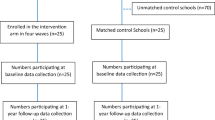Abstract
Fortunate child care directors have many volunteers in their centers. Parents, grandparents, student interns, and other community volunteers may work occasionally or regularly in the child care center. Directors should be prepared to host these volunteers by planning in advance for their orientation. This will make the director's task easier and the volunteers' work more meaningful to them and more useful to the children and staff. At the University of Tennessee's Child Development Laboratories we regularly host volunteers with little or no prior experience in child care. Volunteers from the Foster Grandparents Program, from other departments in the university, parents of the children enrolled in the program, as well as our own majors in the beginning stages of their field work, are frequent participants who require orientation and guidelines for working with young children in group care. Because it is not unusual for some volunteers to leave after a semester, training and orientation for new volunteers occurs regularly throughout the year. The information below is offered to directors to promote meaningful involvement of volunteers in their center.
Similar content being viewed by others
Selected Bibliography
Interaction and Communication with Children
Clemens, S.G. (1983).The sun's not broken, a cloud's just in the way: On child-centered teaching. Mt. Ranier, MD: Gryphon House.
Hirtz, R., & Driscoll, A. (1988). Praise or encouragement? New insights into praise: Implications for early childhood teachers.Young Children, 43(5), 6–13.
Hodges, W. (1987). Teachers-children: Developing relationships.Dimensions, 15(4), 12–14.
Kamii, C. (1984). Obedience is not enough.Young Children, 39(4), 11–14.
Shoemaker, P. (1987). Teacher-child communications: Styles and strategies.Dimensions, 15(4), 15–16.
Smith, C., & Davis, D. (1976). Teaching children non-sense.Young Children, 31 (6), 428–447.
Warren, R. (1977).Caring: Supporting children's growth. Washington, DC: National Association for the Education of Young Children.
Guidance and Classroom Management
Cherry, C. (1983).Please don't sit on the kids: Alternatives to punitive discipline. Belmont, CA: Pitman Learning, Inc.
Gartrell, D. (1987). Punishment or guidance.Young Children, 42(3), 55–61.
Goffin, S. (1987). Classroom management in a new context: Teacher as decision-maker.Dimensions, 15(4), 5.
Honig, A.S. (1985). Compliance, control, and discipline, Part 1.Young Children, 40(2), 50–58
Honig, A.S. (1985). Compliance, control, and discipline, Part 2.Young Children, 40(3), 47–52.
Marion, M. (1987).Guidance of young children. Columbus, OH: Merrill Publishing Company.
Miller, C. (1984). Building self-control: Discipline for young children.Young Children, 39(1), 15–19.
Mize, J. (1987). An effective classroom management tool for early childhood education.Dimensions, 15(4), 21–24.
Seefeldt, C. (1987). Praise — Good or bad?Dimensions, 15(4), 18–20.
Soderman, A.K. (1985). Dealing with difficult young children: Strategies for teachers and parents.Young Children, 40(5), 15–20.
Stone, J. (1978).A guide to discipline. Washington, DC: National Association for the Education of Young Children.
Weber-Schwartz, N. (1987). Patience or understanding.Young Children, 42(3), 52–54.
Professional Behavior
Allen, J. (1986). Safe touch: Reassurances for children care workers.Day Care and Early Education, 14(2), 14–16.
Allen, J. (1988). Sexual abuse and child care: Turning stumbling blocks into stepping stones.Dimensions, 16(4), 12–14.
Bredekamp, S. (Ed.). (1986).Developmentally appropriate practice. Washington, DC: National Association for the Education of Young Children.
Hankerson, H. (1982). Intervention strategies are the key to relevant curriculum and effective instruction in early childhood education.Early Child Development and Care, 8, 31–43.
Hanline, M.F. (1985). Integrating disabled children.Young Children, 40(2), 45–48.
Katz, L. (1977).Talks with teachers. Washington, DC: National Association for the Education of Young Children.
Mazur, S., & Pekor, C. (1985). Can teachers touch children anymore?Young Children, 40(4), 10–12.
Meddin, B.J., & Rosen, A. (1986). Child abuse and neglect: Prevention and reporting.Young Children, 41(4), 26–30.
Swick, K. (1987). Managing classroom stress.Dimensions, 15(4), 9–11.
Additional information
Jan Allen is Associate Professor in the Department of Child and Family Studies. Kathy Carlson is a Master Teacher in the Child Development Laboratories. They work together at The University of Tennessee in Knoxville, TN. The authors wish to thank Dr. Carol Catron and Anne Miller Farmer for helpful comments.
Rights and permissions
About this article
Cite this article
Allen, J., Carlson, K. Volunteers in the classroom: Guidelines for orientation. Early Childhood Educ J 17, 4–6 (1989). https://doi.org/10.1007/BF01619643
Issue Date:
DOI: https://doi.org/10.1007/BF01619643




